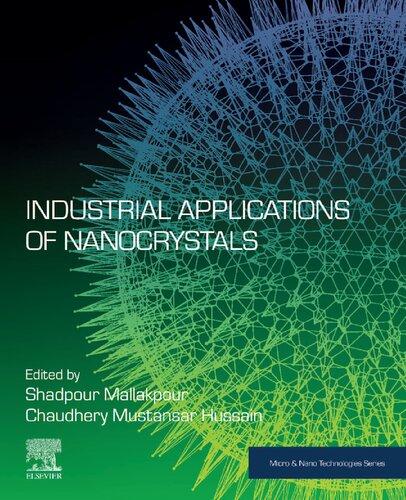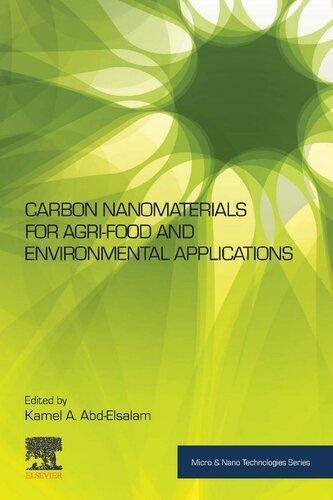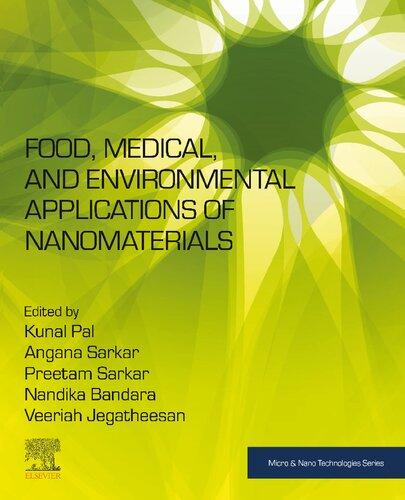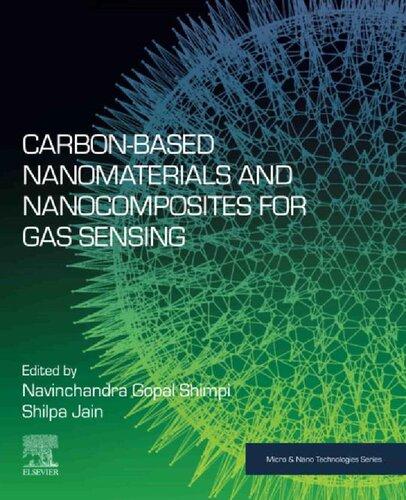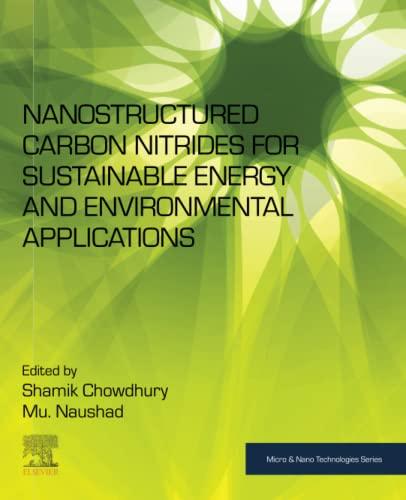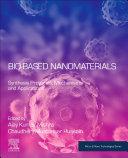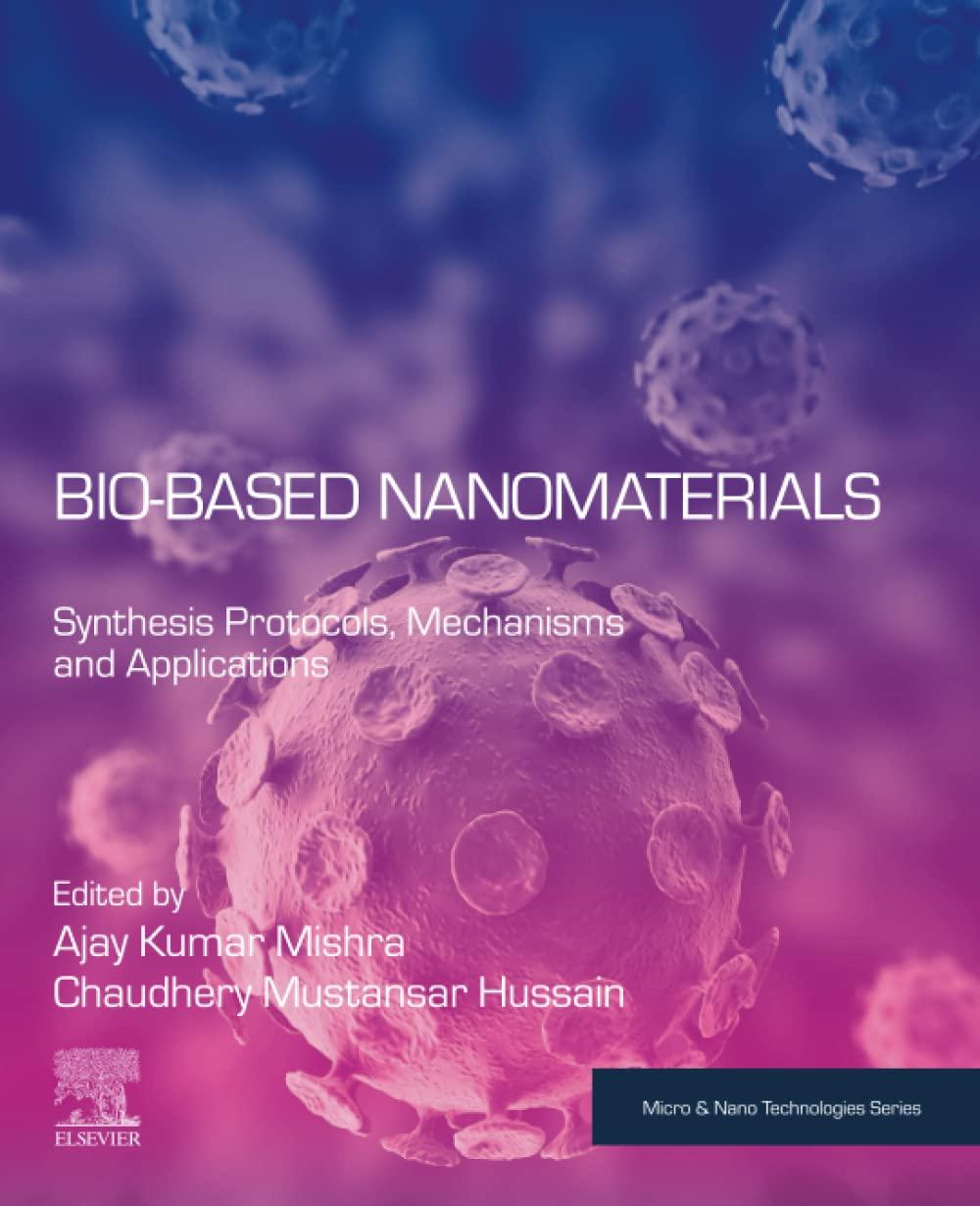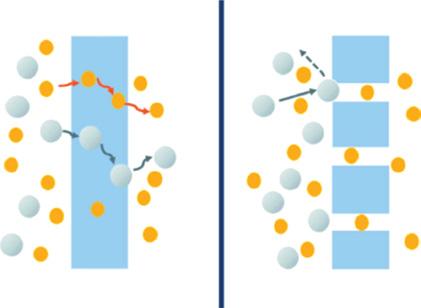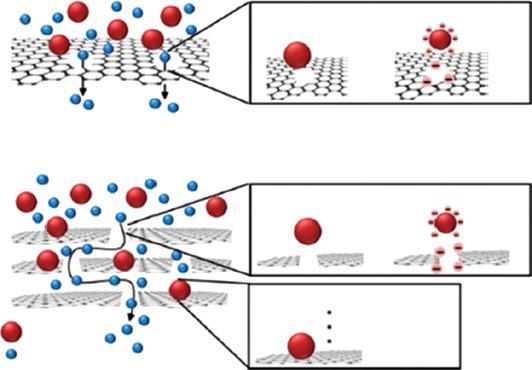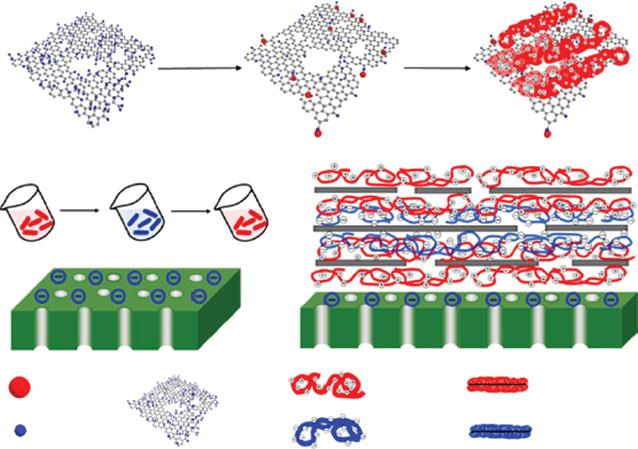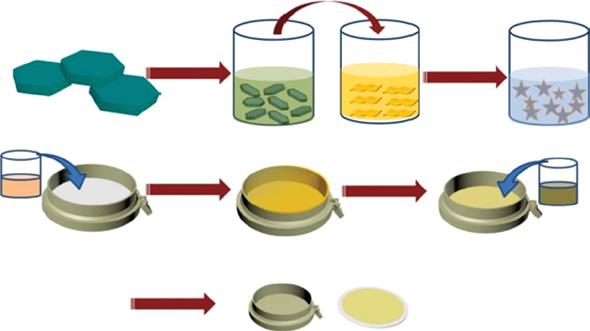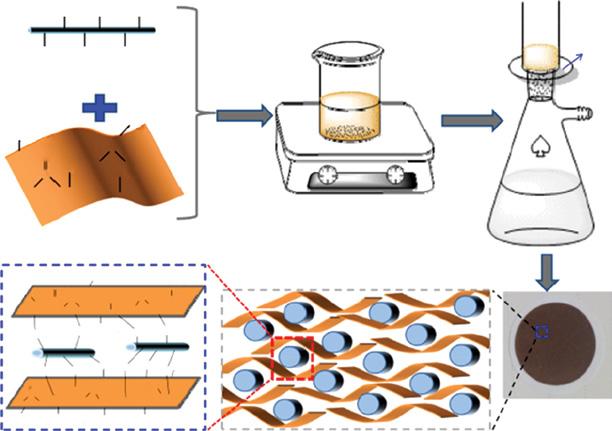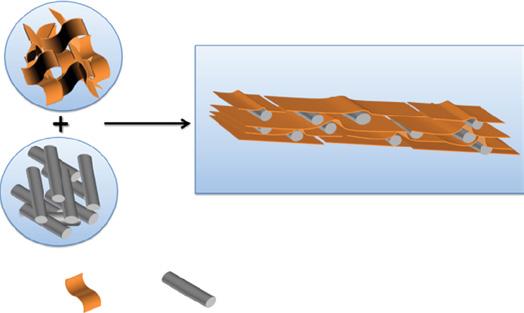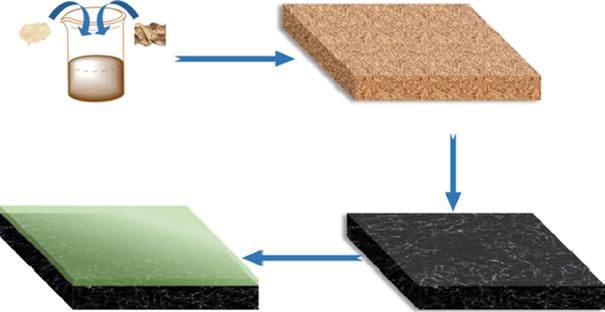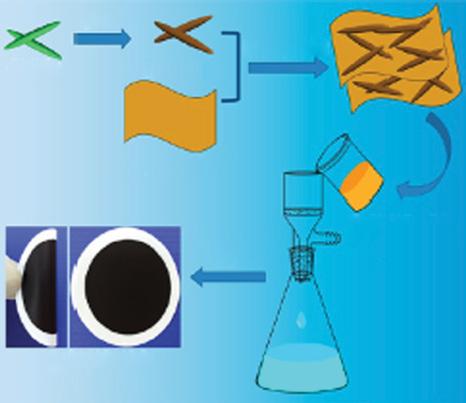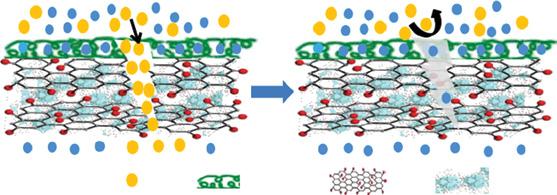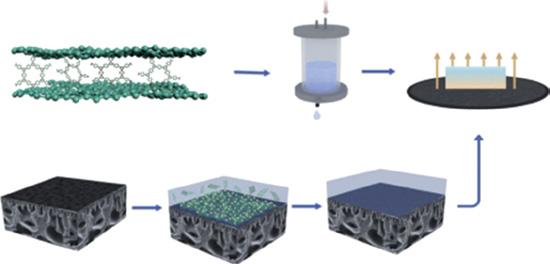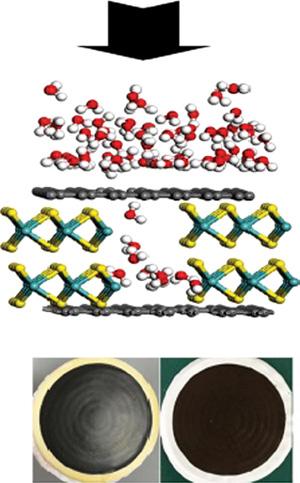Environmental Applications of Carbon Nanomaterials-Based Devices 1st. Edition
Shadpour Mallakpour
Visit to download the full and correct content document: https://ebookmass.com/product/environmental-applications-of-carbon-nanomaterialsbased-devices-1st-edition-shadpour-mallakpour/
More products digital (pdf, epub, mobi) instant download maybe you interests ...
Industrial Applications of Nanocrystals Shadpour Mallakpour
https://ebookmass.com/product/industrial-applications-ofnanocrystals-shadpour-mallakpour/
Chapter 6 - Water treatment and environmental remediation applications of carbon-based nanomaterials Xiaoli Tan & Xin Wang
https://ebookmass.com/product/chapter-6-water-treatment-andenvironmental-remediation-applications-of-carbon-basednanomaterials-xiaoli-tan-xin-wang/
Carbon Nanomaterials for Agri-food and Environmental Applications 1st Edition Kamel A. Abd-Elsalam (Editor)
https://ebookmass.com/product/carbon-nanomaterials-for-agri-foodand-environmental-applications-1st-edition-kamel-a-abd-elsalameditor/
Food, Medical, and Environmental Applications of Nanomaterials Veeriah Jegatheesan
https://ebookmass.com/product/food-medical-and-environmentalapplications-of-nanomaterials-veeriah-jegatheesan/
Carbon-Based Nanomaterials and Nanocomposites for Gas Sensing Navinchandra Gopal Shimpi
https://ebookmass.com/product/carbon-based-nanomaterials-andnanocomposites-for-gas-sensing-navinchandra-gopal-shimpi/
Nanostructured Carbon Nitrides for Sustainable Energy and Environmental Applications 1st Edition Shamik Chowdhury
https://ebookmass.com/product/nanostructured-carbon-nitrides-forsustainable-energy-and-environmental-applications-1st-editionshamik-chowdhury/
Bio-Based Nanomaterials : Synthesis Protocols, Mechanisms and Applications Ajay Kumar Mishra
https://ebookmass.com/product/bio-based-nanomaterials-synthesisprotocols-mechanisms-and-applications-ajay-kumar-mishra-2/
Bio-Based Nanomaterials: Synthesis Protocols,
Mechanisms
and Applications Ajay Kumar Mishra
https://ebookmass.com/product/bio-based-nanomaterials-synthesisprotocols-mechanisms-and-applications-ajay-kumar-mishra/
Industrial Applications of Carbon Nanotubes 1st Edition Peng Huisheng (Ed.)
https://ebookmass.com/product/industrial-applications-of-carbonnanotubes-1st-edition-peng-huisheng-ed/
Environmental Applications of Carbon Nanomaterials-Based Devices
Environmental Applications of Carbon Nanomaterials-Based Devices
Edited by
Shadpour Mallakpour
Chaudhery Mustansar Hussain
Editors
Shadpour Mallakpour
Department of Chemistry
Isfahan University of Technology
8415683111 Khomeini Shahr Isfahan Iran
Chaudhery Mustansar Hussain
Department of Chemistry and Environmental Science
New Jersey Institute of Technology
Newark, New Jersey United States
Cover Design: Wiley
Cover Image: © Rost-9D/Getty Images
All books published by WILEY-VCH are carefully produced. Nevertheless, authors, editors, and publisher do not warrant the information contained in these books, including this book, to be free of errors. Readers are advised to keep in mind that statements, data, illustrations, procedural details or other items may inadvertently be inaccurate.
Library of Congress Card No.: applied for
British Library Cataloguing-in-Publication Data
A catalogue record for this book is available from the British Library.
Bibliographic information published by the Deutsche Nationalbibliothek
The Deutsche Nationalbibliothek lists this publication in the Deutsche Nationalbibliografie; detailed bibliographic data are available on the Internet at <http://dnb.d-nb.de>.
© 2022 WILEY-VCH GmbH, Boschstraße 12, 69469 Weinheim, Germany
All rights reserved (including those of translation into other languages). No part of this book may be reproduced in any form – by photoprinting, microfilm, or any other means – nor transmitted or translated into a machine language without written permission from the publishers. Registered names, trademarks, etc. used in this book, even when not specifically marked as such, are not to be considered unprotected by law.
Print ISBN: 978-3-527-34865-7
ePDF ISBN: 978-3-527-83096-1
ePub ISBN: 978-3-527-83098-5
oBook ISBN: 978-3-527-83097-8
Typesetting Straive, Chennai, India
Printing and Binding
Printed on acid-free paper
10 9 8 7 6 5 4 3 2 1
Contents
1 Graphene-Based Nanomembranes for Sustainable Water Purification Applications 1
Uluvangada T. Uthappa, Dusan Losic, and Mahaveer D. Kurkuri
1.1 Introduction 1
1.2 Graphene and GO-Based Membrane Characteristics and Properties 2
1.3 Fabrication of Graphene-Based Nanomembranes for Water Treatment Applications 4
1.3.1 Desalination 4
1.3.2 Treatment for Dyes 5
1.3.3 Graphene Nanomembranes for Salt and Dye Rejection 5
1.3.4 Translation of Graphene Nanomembranes for Real Applications 23
1.4 Graphene Nanomembranes for Heavy Metals Treatment 24
1.4.1 Heavy Metals 24
1.5 Conclusion and Future Perspectives 25 Acknowledgments 26 Important Websites 26
References 26
2 Magnetic Graphene Oxide and Its Composite Nanomaterials: Application in Environmental Decontamination 33 Karan Chaudhary and Dhanraj T. Masram
2.1 Introduction 33
2.2 Synthesis of Magnetic Graphene Oxide and Its Composite Nanomaterials 35
2.3 Application of Magnetic Graphene Oxide and Its Composite Nanomaterials 36
2.3.1 Removal of Toxic Metal Contaminants 36
2.3.2 Removal of Toxic Organic Contaminants 41
2.3.3 Removal of Other Contaminants 45
2.4 Conclusion 46 Further Reading 46
References 47
3 Biomass- or Biowaste-Derived Carbon Nanoparticles as Promising Materials for Electrochemical Sensing Applications
Anila R. Cherian, Vinay S. Bhat, Anitha Varghese, and Gurumurthy Hegde
3.1 Introduction 53
3.2 Electrochemical Sensors 54
3.3 The Choice of Electrode Materials 54
3.4 Biomass-Derived Porous Carbons 56
3.4.1 Synthesis 56
3.4.1.1 Hydrothermal Carbonization (HTC) 56
3.4.1.2 Pyrolysis 58
3.4.2 Structure and Properties 58
3.5 Biomass-Derived Carbons in Electrochemical Sensing 61
3.5.1 H2O2 Sensing from Okra-Derived Carbons 61
3.5.2 Acetaminophen (AC) Detection by Seaweed-Derived Carbons 62
3.5.3 4-Nitrophenol Detection from Mango Leave-Derived Carbons 65
3.5.4 Bisphenol-A (BPA) Detection Using Bamboo Fungi-Derived Carbon 67
3.5.5 Nitrite Ion Detection by Areca Nut-Derived Carbons 69
3.5.6 Catechin Sensing Using Bougainvillea spectabilis-Derived Carbons 72
3.5.7 Progesterone Sensing by Onion Peel-Derived Carbons 73
3.5.8 Butein Detection from Oil Palm Leave-Derived Carbons 75
3.6 Conclusion and Future Perspective 79 Acknowledgment 79
Website Links 80
References 80
4 Applications of Carbon-Based Nanomaterials for Wastewater Treatment 87 Ramesh K. Guduru, Anurag A. Gupta, Parwathi Pillai, and Swapnil Dharaskar
4.1 Introduction 87
4.2 Wastewater 88
4.3 Wastewater Treatment Methods 89
4.4 Nanomaterials 90
4.5 Carbon-Based Nanomaterials 92
4.6 Adsorption Mechanisms of CNTs and Graphene 93
4.6.1 Adsorption Through Physical and Chemical Methods 93
4.6.2 Adsorption Through Biological Methods 114
4.6.3 Adsorption Using Deep Eutectic Solvents (DESs) 114
4.6.4 CNT- and Graphene-Based Composite Adsorbents 114
4.7 Membrane-Based Filtration of Contaminants Using CNTs and Graphene-Based Materials 115
4.8 Use of CNTs and Derivative Materials as Disinfecting Agents for Water Purification 121
4.9 Commercial Use of CNMs in Wastewater Treatment 122
4.10 Conclusions 122
Recommendations 123
References 123
5 Electrochemical Determination of Indigotine Based on Poly(Gibberellic Acid)-Modified Carbon Nanotube Paste Electrode 135 Girish Tigari, Jamballi G. Manjunatha, and Chenthattil Raril
5.1 Introduction 135
5.2 Experimental 136
5.2.1 Chemicals 136
5.2.2 Bare Carbon Nanotube Paste Electrode (BCNTPE) Preparation 136
5.3 Results and Discussion 136
5.3.1 Electropolymerization of BCNTPE with GA 136
5.3.2 FE-SEM Characterization of BCNTPE and PGAMCNTPE 137
5.3.3 EIS Characterization for PGAMCNTPE and BCNTPE 137
5.3.4 CV Behavior of IT at PGAMCNTPE and BCNTPE 137
5.3.5 Variation of IT Behavior at Different pHs 137
5.3.6 Effect of Voltage Sweep Rate 139
5.3.7 Calibration Curve 140
5.3.8 Reproducible and Stable Sensor 141
5.3.9 Interference Analysis 141
5.3.10 Water Sample Analysis 141
5.4 Conclusion 142
Acknowledgment 143
Important Websites for Reference 143 References 143
6 Toxicity of Carbon Nanomaterials 147
Arpita Adhikari and Joydip Sengupta
6.1 Introduction 147
6.2 Carbon Nanomaterials 149
6.2.1 Fullerene 149
6.2.2 Carbon Nanotube 149
6.2.3 Graphene and Graphene Derivatives 149
6.3 Nanotoxicology and Resulting Cytotoxicity or Cellular Toxicity 151
6.4 Assessment of Nanocytotoxicity 155
6.4.1 Respiratory or Pulmonary Toxicity 155
6.4.2 Dermal or Skin Toxicity 157
6.4.3 Cardiovascular Toxicity 158
6.4.4 Reproductive and Developmental Toxicity 158
6.4.5 Hepatotoxicity or Liver Toxicity 159
6.4.6 Ocular Toxicity 160
6.5 Conclusions 160
Important Websites 161
References 161
7 Fundamentals of Functionalized Carbon Nanomaterials (CNMs) for Environmental Devices and Techniques 173 Kiran Soni and Rekha Yadav
7.1 Introduction 173
7.2 Synthesis 174
7.2.1 Carbon Nanotubes 174
7.2.2 Graphene 175
7.2.3 Fullerenes 176
7.2.4 Carbon Nanocones 176
7.2.5 Functionalization of Nanomaterials 176
7.3 Applications 177
7.3.1 Nanowires 177
7.3.1.1 Carbon Nanotube as Environmental Sensor 177
7.3.1.2 Carbon Nanotubes in Wastewater Treatment 178
7.3.1.3 Carbon Nanotubes in Green Nanocomposite Design 179
7.3.1.4 CNT as Biological Sensor 179
7.3.1.5 CNT as Filler 180
7.3.2 Graphene 181
7.3.2.1 Graphene as Environmental Sensors 182
7.3.2.2 Graphene in Wastewater Treatment 183
7.3.2.3 Graphene as Biological Sensors 185
7.3.2.4 Graphene for Removing Organic Pollutants 186
7.3.3 Fullerenes 188
7.3.3.1 Fullerene as Environmental Sensor 188
7.3.3.2 Fullerene in Wastewater Treatment 188
7.3.3.3 Fullerene as Biological Sensor 188
7.3.3.4 Fullerene in Agriculture 189
7.3.4 Carbon Nanocones 189
7.3.4.1 Carbon Nanocones as Environmental Sensors 189
7.4 Conclusion 190
Useful Links 190
References 190
8 Fundamental of Functionalized Carbon Nanomaterials for Environmental Devices and Techniques 197 Baskaran Ganesh Kumar, P. PonSathieshkumar, and K.S. Prakash
8.1 Introduction 197
8.2 Results and Discussion 199
8.2.1 What Are Carbon Nanomaterials? 199
8.2.1.1 Fullerene 199
8.2.1.2 Carbon Nanotubes 199
8.2.1.3 Graphene 200
8.2.2 Functionalization of CNMs 200
8.2.2.1 Need for Functionalization 200
8.2.2.2 Covalent Functionalization 201
8.2.2.3 Non-covalent Functionalization 208
8.2.3 CNMs for Environment Devices 209
8.2.3.1 Solar Cell 213
8.2.3.2 Gas Sensors by Functionalized CNMs 214
8.2.3.3 Humidity Sensors by Functionalized CNMs 215
8.2.3.4 LEDs by Functionalized CNMs 215
8.2.3.5 Metal Absorption by Functionalized CNMs 216
8.2.3.6 Water Purification by Functionalized CNMs 217
8.3 Conclusion, Challenges, and Future Prospects 218 Acknowledgments 218
Related Web Links 219
References 219
9 Functionalized Magnetic Carbon Nanomaterials for Environmental Remediation 227 Ambika and Pradeep Pratap Singh
9.1 Introduction 227
9.2 Types of Carbon-Based Magnetic Nanocomposites Used in Pollutants Removal from Environment 228
9.2.1 Carbon Nanotubes Based Magnetic Nanocomposites 228
9.2.2 Graphene and Its Derivative Based Magnetic Nanocomposites 228
9.2.3 Fullerenes Based Magnetic Nanocomposites 229
9.2.4 Nanodiamond-Filled Magnetic Nanocomposites 229
9.2.5 Graphitic Carbon Nitride Based Magnetic Nanocomposites 229
9.3 Different Processing Methods for Magnetic Carbon-Based Nanocomposites 229
9.3.1 Melt Blending 229
9.3.2 Hydrothermal Method 230
9.3.3 Co-Precipitation Method 230
9.3.4 In Situ Polymerization 230
9.3.5 Sol–Gel Method 231
9.4 Applications of Magnetic Carbon-Based Nanocomposites 231
9.4.1 Adsorption of Heavy Metals 231
9.4.2 Adsorption of Organic Dye 234
9.4.3 Other Organic Pollutants 236
9.5 Future Prospects 237
9.6 Conclusions 238
Important Websites 238
References 238
10 Functionalized Carbon Nanotubes for Ammonia Sensors 251
Rakshith K. Srinivasreddy and Ravi-Kumar Kadeppagari
10.1 Introduction 251
10.2 Ammonia Sensors 251
10.3 Types and Synthesis of Carbon Nanotubes 253
10.4 Carbon Nanotube-Based Ammonia Sensors 254
10.5 Functionalization of Carbon Nanotubes 257
10.6 Functionalized Carbon Nanotubes for Ammonia Sensors 258
10.7 Conclusions and Future Perspectives 259 Acknowledgments 259
Websites 259
References 259
11 Functionalized Carbon Nano Lab-on-a-Chip Devices for Environment 265
RaviPrakash Magisetty, Naga Srilatha Cheekuramelli, and Radhamanohar Aepuru
11.1 Introduction 265
11.2 Need for Carbon Nano Lab-on-a-Chip Devices for Environment, and Its Advancement 266
11.3 Carbon Nano Lab-on-a-Chip Devices for Environment 267
11.3.1 Renewable Energy Applications 267
11.3.2 Agriculture Applications 268
11.3.3 Biomedical Applications 270
11.3.4 Ocean and Atmospheric Applications 274
11.4 Conclusion 278 Important Websites 279 References 279
12 Functionalized Carbon Nanotubes (FCNTs) as Novel Drug Delivery Systems: Emergent Perspectives from Applications 283 Shikha Gulati, Sanjay Kumar, Ayush Mongia, Anchita Diwan, and Parinita Singh
12.1 About the Chapter 283
12.2 Introduction 284
12.3 Carbon Nanotubes (CNTs) 284
12.4 Classification of CNTs 286
12.4.1 Advantages of Carbon Nanotubes (CNTs) 287
12.4.2 Disadvantages of Carbon Nanotubes (CNTs) 287
12.5 Synthetic Methodologies of CNTs 288
12.5.1 Laser Ablation (LA) Method 288
12.5.2 Electric Arc Discharge (EAD) Method 289
12.5.3 Catalytic Chemical Vapor Deposition (CCVD) Method 289
12.5.4 Electrolysis Method 289
12.6 Purification Techniques of CNTs 290
12.6.1 Vacuum Oven Treatment 291
12.6.2 Microwave Treatment 291
12.6.3 Chemical Oxidation 291
12.6.4 Piranha Treatment 291
12.6.5 Annealing 292
12.6.6 Ultrasonication 292
12.6.7 Magnetic Purification 292
12.6.8 Cutting 292
12.6.9 Chromatography 292
12.7 Need of Functionalization of Carbon Nanotubes (CNTs) 293
12.8 Functionalization Strategies of CNTs 293
12.8.1 Covalent Functionalization 293
12.8.2 Non-covalent Functionalization 295
12.9 Advantages of Functionalized Carbon Nanotubes (FCNTs) 296
12.10 Medicinal Applications of Functionalized Carbon Nanotubes (FCNTs) 296
12.10.1 FCNTs in Drug Delivery 296
12.10.2 FCNTs in Drug Loading 298
12.10.3 FCNTs in Drug Targeting 301
12.10.3.1 Cancer Targeting 301
12.10.3.2 Brain Targeting 302
12.10.3.3 Lymphatic Targeting 302
12.10.3.4 Tuberculosis Targeting 303
12.11 Biocompatibility and Toxicity Considerations of FCNTs 303
12.12 Conclusion and Future Perspective 305
Some Important Websites 306 References 306
13 Adsorptive Removal of Fluoride by Carbon Nanomaterials 313 Tanvir Arfin
13.1 Introduction 313
13.2 Geochemistry of Fluoride 314
13.3 Fluoride in Water 314
13.3.1 Dynamics of Fluoride in Groundwater 315
13.4 Fluoride Solubility and Temperature 316
13.5 Sources of Fluoride in the Environment 316
13.6 Health Effects of Fluoride 316
13.7 Removal Technologies 316
13.8 Classification of Adsorbents 317
13.9 Carbon-Based Adsorbents 317
13.9.1 Carbon Nanomaterials (CNM) 318
13.9.1.1 Carbon Nanotube (CNT) 319
13.9.1.2 Graphene 319
13.10 Conclusion 320 Acknowledgment 321
Important Websites 321 References 321
14 Functionalized Carbon Nano-Membranes Based Devices for Water Purification Technology 331
Lindomar Cordeiro A. de Araújo and Luiz Pereira da Costa
14.1 Introduction 331
14.2 Desalination 333
14.3 Removal of Particles (Ions, Heavy Metals) 335
14.4 Removal of Microorganisms 336
14.5 Final Considerations 339
Websites on the Topic 339
References 339
15 Functionalized Bio-carbon Nanomaterials for Environmental Utilizations 347
Mahtabin R. Rozbu, Ahmedul Kabir, and Paulraj M. Selvakumar
15.1 Introduction 347
15.2 Carbon Nanomaterial 349
15.3 Synthesis of Fullerenes 349
15.4 Synthesis of CNTs 350
15.5 Synthesis of Graphenes 350
15.6 Bio-carbon Nanomaterials 351
15.7 Functionalization of Nanom\aterials 351
15.7.1 Importance of Functionalization 352
15.8 Nanocellulose 352
15.8.1 Synthesis of Nanocellulose (NC) 352
15.8.2 Synthesis of CNCs 353
15.8.3 Synthesis of CNFs 353
15.8.4 Synthesis of DCCs 354
15.8.5 Synthesis of BNC 354
15.8.6 Applications 354
15.8.6.1 NC in Purification Technology as Films and Foams 354
15.8.7 NC as Solar Cells 355
15.8.8 NC as Stabilizing Agent 355
15.8.9 NC in Biomedicine 355
15.9 Nitrogen and Sulfur Co-doped Bio-carbon 356
15.9.1 Application Co-doped Bio-carbon 356
15.10 Biochar 356
15.10.1 Application of Biochar 357
15.10.1.1 Application of Bio-carbon Derived from Sisal Leaves 357
15.11 Biopolymers 357
15.11.1 Biopolymers in “Green” Synthesis of Nanoparticles 357
15.11.2 Biopolymers in Waste Water Treatments 358
15.11.3 Biopolymers as Bioplastics 358
15.11.4 Nanocomposites 358
15.11.5 Peptide Nanoparticles 359
15.11.5.1 Dipeptides 359
15.11.5.2 Peptide Amphiphiles 359
15.11.5.3 Dendrimers 360
15.11.5.4 Coiled-Coil Peptides 360
15.11.5.5 Peptide–Nucleic Acid Complexes 360
15.11.5.6 Casein Micelles 360
15.11.5.7 Peptide Nanotubes 360
15.11.6 Further Application of Bio-carbon Nanomaterials as Devices 361
15.11.7 Characterization Technique 361
15.12 Conclusion 362
Important Websites 363
References 363
16 Carbon-Based Nanomaterials in Drug Delivery Systems 375 Subhendu Chakroborty and Suban K. Sahoo
16.1 Introduction 375
16.2 Carbon Nanomaterials in Drug Delivery 375
16.2.1 Carbon Nanotubes (CNTs) in Drug Delivery 375
16.2.2 Graphene Oxide (GO) in Drug Delivery 379
16.2.3 Carbon Dots (CDs) in Drug Delivery 384
16.2.4 Nanodiamonds (NDs) in Drug Delivery 387
16.3 Conclusions 389
Important Websites on Drug Delivery Systems 389
References 389
17 Functionalized Carbon Nanomaterials (FCNMs): A Green and Sustainable Vision 395 Upasana Issar and Richa Arora
17.1 Introduction 395
17.2 Environment-Friendly and Greener Ways to Synthesize FCNMs 396
17.3 Applications of FCNMs for a Green and Sustainable Environment 398
17.3.1 FCNMs in Wastewater Remediation 398
17.3.2 FCNMs in Air Pollution Remediation 400
17.3.3 FCNMs in Nuclear Waste Management 401
17.3.4 FCNMs as Electrocatalysts and Photocatalysts 402
17.3.5 FCNMs for Energy Storage 403
17.3.5.1 FCNMs and Solar Cells 403
17.3.5.2 FCNMs and Supercapacitors 405
17.3.5.3 FCNMs and Hydrogen Storage 406
17.3.5.4 FCNMs and Fuel Cell 407
17.3.6 FCNMs and Biofuels 408
17.3.7 FCNMs as Nanofertilizers 409
17.3.8 Miscellaneous Applications 409
17.4 Summary 410
Some Important Weblinks Related to Applications of FCNMs 410 References 410
18 Functionalized Carbon Nanomaterials for Impending Pharmaceutical Applications: A Green and Sustainable Vision 423 Vaneet Kumar, Saruchi, and Harsh Kumar
18.1 Introduction 423
18.2 Carbon Nanotubes: Functionalization for Biomedical Applications 424
18.2.1 Applications of Functionalization Carbon Nanotubes in the Pharmaceutical Field 426
18.2.2 Treatments of Tumors by Functionalized CNT 428
18.2.3 Treatment of Infectious Diseases by Functionalized CNT 428
18.2.4 Functionalized CNT as Antioxidants 429
18.2.5 Functionalized CNTs as Diagnostics 429
18.2.6 Solid Phase Extraction of Drugs and Biochemical’s with CNTs 430
18.2.7 Toxicity Contemplation of CNTs 431
18.3 Conclusion and Future Perspectives 432
Important Websites about the Topic 433
References 433
Index 439
Graphene-Based
Nanomembranes for Sustainable Water
Purification Applications
Uluvangada
T. Uthappa1, Dusan Losic2,3, and Mahaveer D. Kurkuri1
1 JAIN University, Centre for Nano and Material Sciences, JAIN Global Campus, Bengaluru, Karnataka, 562112, India
2 The University of Adelaide, School of Chemical Engineering, Adelaide, SA, 5005, Australia
3 The University of Adelaide, ARC Research Hub for Graphene Enabled Industry Transformation, Adelaide, SA, 5005, Australia
1.1 Introduction
The global crisis on water scarcity ranks top among the world’s major problems. Provided with recent statistics, two-thirds of the world population will face major difficulties by 2025 due to the lack of water facilities. Due to the rapid population expansion, industrial development, and water pollution, it incessantly depleted freshwater resources. The extreme consumption of freshwater resources, particularly for developing countries, due to the growth of agriculture and industrial activities completely dependent on water resources and continuous utilization leads to severe ecological disasters. Thus, the shortage of water resources is an alarming issue that needs urgent resolution. To address these problems, it is crucial to conserve water resources [1].
On the other hand, membrane technology is a separation process that permeates certain species to pass via membrane while controlling the others, which is completely dependent on the properties of the membrane material. Based on their properties, membranes can be categorized as dense and porous membranes according to the driving force and ionic and molecular movement transported through membranes. Usually, it is well recognized that diverse species permeate based on the specific diffusion rates via the membranes, which are generally influenced based on solubility, diffusivity, and the membranes’ porosity, as represented in Figure 1.1.
It is believed that the smaller molecules might pass through the membrane and whereas others could be blocked based on the pore sizes of the membranes. The ceramic and polymers are the most widely used membranes for water purifications plants. Typically, ceramic membranes retain better thermal and mechanical properties. However, it is difficult to control the pore size accurately with low-cost approaches. In contrast, polymeric membranes are economically and extensively utilized in microfiltration (MF), ultrafiltration (UF), nanofiltration (NF), and reverse osmosis (RO) process due to the rapid permeation and high
Environmental Applications of Carbon Nanomaterials-Based Devices, First Edition. Edited by Shadpour Mallakpour and Chaudhery Mustansar Hussain. © 2022 WILEY-VCH GmbH. Published 2022 by WILEY-VCH GmbH.
© 2018 Royal Society of Chemistry.
selectivity. However, polymers are hydrophobic that can easily adsorb target pollutants that lead to membrane fouling. Compared to ceramic and polymeric membranes, the new astonishing classic example used in membrane technology is recently discovered graphene oxide (GO). Also, reduced graphene oxide (rGO) is an important alternative class that belongs to the graphene derivative that has been explored for the development of a new generation of membrane separation technology [2]. Since from past few years’ research expansion in graphene known as two-dimensional (2D) carbon allotrope and their oxidized derivatives (GO) has rapidly developed by the drastic increase in publications and patents. It is important to mention that graphene and GO have distinctive favorable material advantages compared to carbon nanotubes (CNTs) concerning separation and purification technologies. GO can be easily fabricated and engineered with favorable size, surface chemistry/modification, and structural properties. Moreover, its industrial process consumes a lesser amount of energy, making their production cost economic (for example: 500–1000 MJ/kg by solvent exfoliation of graphite or chemical reduction of GO, when compared to CNTs 100 000 MJ/kg) [3].
This chapter summarizes the very recent advances on graphene-based nanomembranes for water purifications. The properties of GO-based membranes and fabrication strategies of various graphene-based nanomembranes and their applications in desalination and dyes and some highlights on heavy metals treatment are elucidated and discussed. Finally, a conclusion and future perspectives have been provided. This current book chapter could help the researchers and experts in membrane technology working on GO-based nanomembranes for water treatment applications.
1.2 Graphene and GO-Based Membrane Characteristics and Properties
For the first time, graphene was witnessed in electron microscopes in 1962 supported on the metal surfaces. Further, it was again rediscovered in 2004 by Novoselov and Geim and awarded Nobel Prize in Physics 2010 due to their groundbreaking experiments on 2D (a)
Figure 1.1 Transport mechanism for dense (a) and porous membrane (b). Source: Lyu et al. [2].
1.2 Grapheneand GG-Based embrane haracteristicsand Properties 3
material graphene. Since 2010, graphene has fascinated major attractions in several applications, including water purification. Graphene contains carbon atoms bonded to each other in hexagonal patterns. The monolayered and double-layered graphene is very thin, and so it can be regarded as 2D material. Graphene’s flat based honeycomb arrangements are responsible for favorable characteristic features such as strongest, lightest, most conductive, transparent materials [4], high specific surface area (2600 m2/g), flexibility [5, 6], and large scale production from cheap raw material (graphite) [7]. GO is an oxidized form of graphene, made up of carbon atoms bonded in hexagonal honeycomb lattice structures. Based on strong oxidations surrounding environment and based on the synthetic protocol such as Hummers or Staudenmaier method, enormous groups of oxygen epoxide, hydroxyl, and carboxyl acid functional groups present in GO are represented in Figure 1.2. Such diverse functional groups are responsible for better hydrophilicity and permit better dispersion of GO flakes in aqueous media. These substantial features significantly enable GO deposition from solution using water as an environmentally benign solvent. From the past few years, GO showed unlimited attention as a novel 2D membrane in water treatment applications due to its exceptional mechanical [8] and antifouling properties [9], atomically thin thickness, and outstanding dispersion in water [8]. Various composite membranes are obtained by mixing GO with different polymers and other surface enriched materials. Such studies have been carried to enhance surface properties such as conductivity, tensile strength, and or elasticity of materials [4]. These surface properties impart GO-based functionalized nanomembranes for advanced water treatment technologies. The selective permeation path of graphene-based membranes that allow separation via the nanopore structure originated within the basal plane of hexagonal crystalline structures.
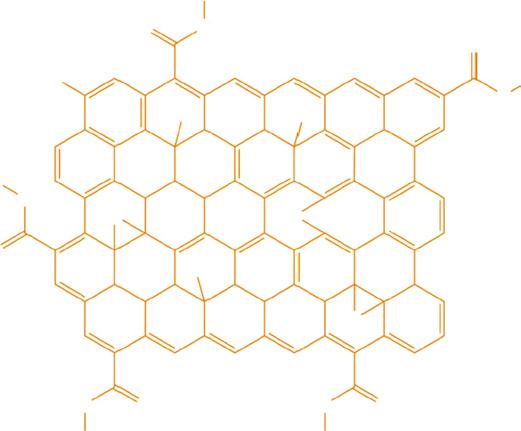
Figure 1.2 Typical chemical structure of GO showing graphene sheet derivatized by phenyl epoxide, hydroxyl groups on the basal plane, and carboxylic group on the edge.
Figure 1.3 Selective permeation routes in nanoporous graphene and stacked sheets of GO. (a) Nanoporous graphene membrane and (b) stacked graphene oxide membrane.
Source: Dervin et al. [9]. © 2016 Royal Society of Chemistry.
On the other hand, ions or molecules are selectively transported or passed via interlayer spacing of 2D graphene-based materials. The stacked nanosheets of GO form a multilayer laminate that shows abundant mechanical strength for application in pressure-assisted water filtration due to strong hydrogen bonds among distinct sheets. The oxygen comprising functional groups deposited haphazardly beside the edges of GO sheets, which maintain both significant interlayer spacing between and empty spaces among non-oxidized areas, constituting a network of nanocapillaries within the film. These nanochannels allow penetration of water molecules and successive transport laterally on hydrophobic nonoxidized regions of membranes that could support the rapid flow of water molecules. Thus liquid, vapors, and gases are opposed, as shown in Figure 1.3. In addition, water-soluble oxygen functional groups present beside the GO sheets, which adsorb water molecules and further diffused between the non-polar hydrocarbon present on the backbone of GO. Such permeation of water escalates the interlayer spacing in the middle of stacked GO sheets and helps in water flux over nanochannels at a higher flow rate. It has also been recognized that smaller ions enter GO membranes considerably superior to simple diffusion. Conversely, enlargement of nanochannels during the hydrated state only accepts ions of analogous sizes [9].
1.3 Fabrication of Graphene-Based Nanomembranes for Water Treatment Applications
1.3.1 Desalination
The membrane-based desalination method is classified based on membrane pore size and rejection mechanisms [10]. Desalination is a process of removing salts from seawater or
1.3 abricationof Graphene-BasedNanomembranesfor Water reatmentApplications 5
brackish water, and it is known to be the core technology for improving freshwater scarcity [11]. To improve the desalination process and enhance water treatments, innovative technological classes of membrane systems are advanced. However, to overcome the costs and energy demands accompanied by membrane treatment, advanced, innovative, and economical membranes are highly desirable [9].
1.3.2 Treatment for Dyes
Many dyes are used to color the products from various industries such as food, paints, leather, plastics, and textiles. The significant amount of effluents from those industries creates serious ecological complications to the environment for most of the underground and surface water bodies. Moreover, dye waste turbidity results in blocking sunlight and reducing diffusion into the water that could obstruct the biological process. As far as concerned, organic dyes are highly stable, toxic, carcinogenic, and mutagenic. In some cases, these properties lead to organ damage and abnormalities in living creatures. As a result, it is crucial to treat or remove such dyes before discharging them into environments [12].
1.3.3 Graphene Nanomembranes for Salt and Dye Rejection
In this report, charged nanochannels produced in polyelectrolyte intercalated amine reduced graphene oxide membranes (PE-ArGO membrane) were reported. The overall synthetic process is shown in Figure 1.4. The PE-ArGO membrane with a rejection sheet of around 160 nm in thickness with laminate structural topographies with a smooth top surface of low roughness of around 17.2 nm. The PE-ArGO membrane was in situ modified
Figure 1.4 Schematic showing synthetic for PE-ArGO membrane. Source: Song et al. [13]. © 2017 American Chemical Society.
1 Graphene-Based Nanomembranes for Sustainable Water Purification Applications
(m-PE-ArGO) using free chlorine scavenging to adjust the charge, though keeping modification to the layered structure in a nominal way. The PE-ArGO and m-PE-ArGO membrane surface charge were +4.37 and −4.28 mC/m2. Using the pressure-assisted technique, pure water permeability for PE@ArGO and m-PE@ArGO membrane was 2.8 and 10.8 LM2/h/bar. The salt rejection is extremely dependent on the charge density of membranes, valence of co-ions, and size of hydrated ions. The rejection of slats for positively charged PE-ArGO membrane follows in the order of: R (MgCl2), 93% > R (NaCl), 88% = R (MgSO4), 88% > R (Na2SO4), 65%, whereas R (Na2SO4), 90% > R (NaCl), 85% > R (MgSO4), 68% > R (MgCl2), 42% followed trend for negatively charged m-PE-ArGO membranes. Altogether, this is the first report on high density positive/negative charge gated ion transport behavior studies reported in GO-based membranes [13].
Stationary repulsion force and π–π contact among GO nanosheets have been tuned using interlayer functionalization and external treatment. Negatively charged congo red (CR) dye with π orbital adsorbed on the nonoxide domain of GO nanosheets, interlayers cross-linked by Ca2+ ions via chelating reaction. The GO–CR nanosheets π–π stacking interactions altered by thermal reduction of GO/Ca/CR membrane using the hot pressing method. The interlayer spacing of GO/Ca/CR membranes tuned from 3.20 to 5.7 Å under dry conditions is observed. In wet conditions, 7.7–11 Å. In the meantime, modified GO membranes’ swelling behavior decreased compared to the bare GO bare membrane. Notably, the prepared membrane showed a permeation flux of 17 LM2/h/bar, and the rejection for methylene blue (MB) was 99.5% [14].
Wang et al. demonstrated exfoliated hydrotalcite/graphene oxide (EHT/GO) nanosheet combined through flocculation deposition and homogeneously dispersed in polyethyleneimine (PEI) solution used as an aqueous phase for interfacial polymerization. An overview of the synthetic process is shown in Figure 1.5. The prepared hybrid membranes EHT/GO displayed improved positively charged property after integrating EHT/GO into polyamide (PA) membrane compared with pristine NF and GO incorporated NF membrane. EHT/GO exhibited a more promising transport channel of water molecules
HT
GO
Aqueous phase
Figure 1.5 Overview of the synthetic process of EHT/GO hybrid nanosheets and nanofiltration membranes. Source: Wang et al. [15]. © 2019 Elsevier.
1.3 abricationof Graphene-BasedNanomembranesfor Water
resulting in improved water flux of 26 LM2/h/bar at 0.8 MPa. To this, the membrane rejection performances were 97% and 32% for 1000 ppm of Mg2Cl2 and Na2SO4 feed solutions, presenting prospective use in hard water softening applications [15].
The high rejection of organic dyes graphene oxide/attapulgite (GO/APT) composite nanofiltration membrane was developed using the vacuum-assisted filtration method. The composite membrane was fabricated by a meticulous assembly of APT nanorods incorporated into the interlayers of GO nanosheets. The APT nanorods are easily intercalated into the stacked GO lamellar layers to form stable C O Si bonds undergoing 3D network laminate assembly through the surface grafting functionalization. It showed a significant role in enhanced performance in water permeability. Compared with the bare GO membrane, the GO/APT membrane showed fourfold water flux performance while maintaining a high rejection rate of almost 100% for rhodamine b (RhB) dye molecules. The reason could be due to d-spacing, hydrophilicity, and 3D network lamellar structural properties. The separation mechanism was also evaluated for the GO/APT membrane with different positively/ negatively charged and neutral dyes. Based on the size exclusion and electrostatic interactions, selective permeation could be done using GO/APT membranes [16]. An overview of the synthetic process is shown in Figure 1.6.
Thin-film nanocomposite (TFN) acts as an ideal platform to enhance water permeability of commercially available PA membranes in RO desalination. Thus, nitrogen-doped graphene oxide quantum dots (N-GOQD) fabricated PA/N-GOQD TFN membranes by interfacial polymerization for RO desalination applications. It is noteworthy to mention after the addition of 0.02 wt/v% N-GOQD into the PA membrane, there was a sudden enhancement of water permeability by almost three times, retaining identical salt rejection of pristine PA membrane. Improved water permeability leads to enhanced hydrophilicity of the
PC filter
Ultrasonication, mixed, stirred Vacuum filtration
Figure 1.6 Synthetic process for GO/APT nanocomposite membrane. Source: Wang et al. [16]. © 2019 Elsevier.
1 Graphene-Based Nanomembranes for Sustainable Water Purification Applications
membrane surface, enhanced actual membrane surface area, and a large cavity at the interface between N-GOQD and PA matrix [17].
Cheng et al. fabricated reduced graphene oxide-gold nanoparticle (rGO-AuNP) membrane by vacuum filtration for wastewater dye treatment applications. Using the TEM technique, the size of AuNPs on the rGO surface measured about 8–10 nm in size. The layer by layer (LBL) stacking of rGO-AuNP showed a high flux of 204 LM2/h/bar and retention of 99% for RhB dye molecules [18].
GO membranes are recognized as potential candidates in separation technology. Nonetheless, their instability in aqueous environments is the drawback in real-time applications. Ma et al. designed facile eco-friendly intercalation of montmorillonite (MMT) nano patches on GO to form stable membranes, addressing such complications. The developed stable membranes showed a high water flux of 139.5 LM2/h/bar under 0.01 MPa. Further, for various organic dye molecules such as congo red (CR), RhB, crystal violet (CV), methylene blue (MB) showed 98.75%, 99.44%, 99.90%, and 99.94% respectively [19].
In this study, carboxylation of GO nanosheets was carried out through a series of multiple oxidation methods and nucleophilic substitution reactions. Graphene acidic (GA) membrane fabricated using carboxylation of GO nanosheets through the multiple oxidation process. The developed GA membranes showed high water permeability and enhanced salt rejections when associated with bare GO and modified GO membranes with surface negative charge and hydrophilicity. GA membrane showed pure water flux of 73.5 LM2/h/bar and peak rejection of 64% and 95% for 2000 mg/l NaCl and Na2SO4 feed solutions at 1.5 MPa [20].
In an aqueous solution in the absence of organic solvents GO, rGO, and graphene oxide/ polyacrylamide (GO/PAM), nanofiltration membranes are prepared using vacuum filtration. The hydrophilicity of such developed graphene-based membranes was analyzed using contact angle measurements by using X-ray diffraction interlayer spacing of various membranes such as GO (0.85 nm), GO/PAM (0.68 nm), and rGO (0.36 nm). The performance studies of all these graphene-based membranes were carried out using dead-end filtration mode. The water flux and retention for RhB dye showed 399 LM2/h/bar, 85% for GO and 188.89 LM2/h/bar, 95.43% for GO/PAM and 85.85 LM2/h/bar, 97% for rGO membranes. The GO/PAM membranes showed the best separation performance due to the actual fine-tuning of interlayer spacing. These could be potential membranes for high performance in water purification applications [21].
To address global water issues, forward osmosis (FO) based water treatment showed an immense impact. However, it has some limitations in practical application, like the lack of FO membranes with high permeability and selectivity. The novel reduced GO/CNT hollow fiber through electrophoretic deposition coupling with chemical reduction process with high FO performances was evaluated. Two main factors were noted. One is due to the ultralow friction, and distinct interlayer spacing of rGO showed higher water permeability and selectivity. The second factor is high porosity, and improved wettability warranted the CNT hollow fiber with low internal concentration polarization ensured and enhanced water flux. Using deionized water feed at a 0.5 M NaCl draw solution (DS), reduced GO/CNT showed exceptional water flux of 22.6 LMH, indicating 3.3 times greater than the commercial membrane. In the meantime, its reverse salt flux displayed only 1.6 gMH compared to 2.2 gMH for commercial membrane. The obtained results suggest that the rGO/CNT membrane could be a substituent for clean water supply in the FO process [22].
1.3 abricationof Graphene-BasedNanomembranesfor Water
Cellulose acetate (CA)/GO nanocomposites were fabricated for seawater desalination using the phase inversion method. GO nanosheets with grain size 2.7 nm were added to the CA matrix and casting CA/GO onto polyester fabric to enact asymmetric CA (RO) membranes to enhance thermal and mechanical stability. Further, the addition of GO into the CA matrix altered the porosity structure. Meanwhile, synthetic seawater rejection of CA membrane modified with 1 wt% GO showed almost 90% (80% more salt rejection of bare CA membrane) for 25 000 ppm NaCl at 25 bar, which is 1.8 more when compared to bare CA membrane. Also, the flux of the CA membrane showed minor reduction (30% decrease) in the presence of 1 wt% GO showing prospective in seawater desalination [23].
Kang et al. developed graphene oxide-oxidized carbon nanotubes-layer by layer assembly (GO-OCNTs-LBL) with different bilayers on polyethersulfone (PES) membranes. The insertion of OCNTs on the GO interlayer for GO-OCNTs-LBL membrane controls the enlargement of GO. Few other studies were inspected using various salts such as NaCl, MgCl2, Na2SO4, sucrose as DSs, and deionized water as feed. GO-OCNTs-LBL membranes showed high water flux than GO-LBL (control) for NaCl, MgCl2, Na2SO4, and sucrose as DS. The solute flux of GO-OCNTs-LBL membrane for NaCl decreased by 70% than that of GO-LBL membrane. Consequently, the GO-OCNTs-LBL membrane showed superior rejection performances for NaCl than the GO-LBL membrane alone [24].
A polydopamine (PDA) functionalized reduced graphene oxide-metal organic frameworks (rGO-MOFs-HKUST-1) nanocomposites were developed with expeditious rejection capacity for organic dye. In this work, MOFs-HKUST-1 based on rGO was functionalized with PDA. These PDA-rGO-MOFs-HKUST-1 nanocomposites formed on the surface of commercially available CA membrane. The addition of HKUST-1 and cross-linking functionalization of PDA showed excellent rejection, flux, hydrophilic, and antifouling performances. The prepared nanocomposite membrane (PDA-rGO-MOFs-HKUST-1) could successfully reject methylene blue (99.8%) and congo red (CR) 89% efficiently. Further, it is important to note that the flux of the PDA-rGO-MOFs-HKUST-1 membrane showed a drastic increase of 31-fold due to HKUST-1 and PDA [25]. The schematic showing mechanisms involved in PDA-rGO-MOFs-HKUST nanocomposites shown in Figure 1.7.
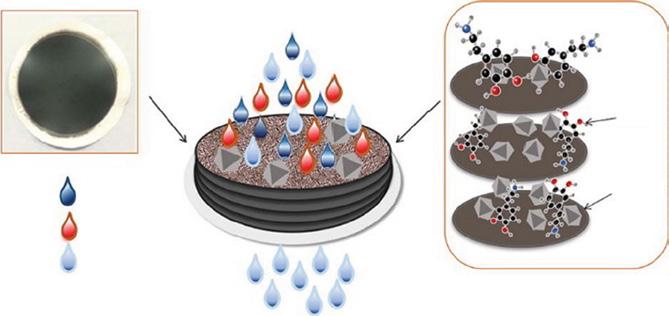
Figure 1.7 Schematic showing mechanisms involved in PDA-rGO-MOFs-HKUST nanocomposites. Source: Liu et al. [25]. © 2019 Elsevier.
Methylene blue
PDA HKUST-1 Congo red H2O
Figure 1.8 Schematic self-assembly of GO/ATP membranes. Source: Luo et al. [26]. © 2019 Elsevier.
Lee et al. effectively surface-functionalized EDTA-rGO membranes for nanofiltration. The EDTA-rGO membranes’ surface was eventually treated with oxygen plasma to boost its water permeability and denoted (P-EDTA-rGO). The P-EDTA-rGO showed 80% of rejection for NaCl salt and water permeance of 150 LM2/h/bar, showing 15 times greater than before plasma surface treatment. The developed P-EDTA-rGO nanofiltration membrane caused high rejection rates. Permeabilities of the small interlayer spacing (5.7 Å) is due to EDTA functionalization and improved hydrophilicity from enhanced plasma treatment [25].
In this work, the attapulgite (ATP) nanofibers/GO composite membrane is self-assembled by mixed solutions containing both ATP and GO shown in Figure 1.8. ATP nanofibers intercalated on GO nanosheets interlayers, acting as laminate structures for effectual trails for water molecules GO. Besides, ATP nanofibers able to widen mass transfer channels and able to promote hydration capacity. The permeate flux from 28.64 LM2/h/bar for GO membranes (control) to 221 LM2/h/bar for ATP/GO membranes was observed and showed extraordinary rejection rates for organic dye molecules such as CBB R250 99.88% and 99.93% for TMPyP [26].
In membrane studies, particularly in water treatment, stability is one of the major problems. In this work, Fang et al. constructed a highly water stable GO-based metal-organic framework (MOF) (UiO66) composite membrane was designed. The construction of substrate involves two main steps: (i) doping GO nanosheets into the membrane casting solution comprising polyacrylonitrile (PAN) that forms 2D–3D inter-connecting pores by phase inversion mode designated as GO-PAN, and (ii) immersing GO-PAN into dopamine solution, which undergoes self-polymerization undergoes to form better compatible and flexible substrate denoted as PGP. The UiO66 layer was assembled by vacuum-assisted filtration technique on porous PGP support illustrated in Figure 1.9. The stable GO-based UiO66/ PAN, known as thin-film composite membrane, showed higher water flux 31.33 LM2/h/bar and maintaining an effective rejection rate of >94% for various dyes such as congo red, methyl orange (MO), methylene blue, and RhB [27].
In other work, the graphene oxide framework (GOF) was designed via “from” and “to” cross-linking approaches. GOF with compact nanochannels were fabricated by LBL using branched polyethyleneimine (BPEI), GO, and thiourea particles as the well-defined
1.3 abricationof Graphene-BasedNanomembranesfor Water
CuSO4/H2O2 induced PDA self-
Figure 1.9 Overview process involved in the UiO66/PGP-TFC NF membrane process. Source: Fang et al. [27]. © 2020 Elsevier.
building blocks. The surface morphology of BPEI/GO/thiourea membranes revealed with compact GOF arrangement with very narrow interlamellar spacing (0.49 nm) when matched to BPEI/GO membranes (0.52 nm). Structural interpretation revealed thiourea partially reduced GO molecules mediated as “to” cross-linker linking adjacent GO nanosheets. While the GO deposition BPEI accomplished as “from” cross-linker by binding thiourea linked GO laminates to form highly stable membranes. The GOF membrane performances showed rejection of 99.5% for both anionic and cationic dyes like methyl orange and RhB. The BPEI/GO/thiourea membrane synthesized with 12 bilayers using 0.25 mg/ ml of GO concentrations showed pure water flux of 24 LM2/h/bar and Na2SO4 rejection of 94%, showing permeability 2.5 times when compared with commercially available nanofiltration membrane. More importantly, BPEI/GO/thiourea showed excellent stability in both acid and basic aqueous solutions [28].
A 3D graphene oxide hydrogel membranes (GOHMs) designed by gelation of GO with ferrous ions through vacuum aided filtration and their application shown in Figure 1.10. In this work, ferrous ions assisted as cross-linkers, which enhanced bonding strength between
Vacuum filtration
Ferrous ions Methylene blue Silver nanoparticle Congo red Adsorption Electrostatic repulsionPhysical screening
Figure 1.10 Schematic of GOHMs membrane preparation and retention mechanisms of target pollutants. Source: Chen et al. [29]. © 2019 Royal Society of Chemistry.
Casting solution
GP substrate
UiO-66/PGP TFC membrane
PGP support layer
PAN GO
Phase inversion
Vacuum filtration
polymerization
Figure 1.11 Schematic illustration of D-ChNCs and D-ChNCs/GO composite membranes. Source: Ou et al. [30]. © 2019 American Chemical Society.
GO nanosheets to prompt microstructure formation of GO via cation π interactions to form 3D lamellar porous structures. In contrast, with pristine GO membranes, the GOHMs exhibited superior water stability and enhanced water permeability of 111 LM2/h/bar and retention performances of >99% for methylene blue and congo red dyes [29].
In this work, free-standing chitin nanocrystals (ChNCs) was modified by dopamine (D) to form GO composites and labeled as D-ChNCs-GO, and their schematic is shown in Figure 1.11. The hydrophilicity is purely based on the contents of D-ChNCs that displays a very sharp increase in water flux from 8.8 for bare GO to 135.6 LM2/h/bar for D-ChNCs-GO composite membranes. Additionally, the rejection rates for methylene blue and congo red dye showed 99.3% and 98.3% of removal performances [30].
Januario et al. modified the PES microfiltration membrane with sulfuric acid, titanium dioxide (TiO2), and GO solutions using the LBL self-assembly method through an electrostatic interactions pressure-driven filtration system. The separation performances of the designed membrane for various charged dye molecules were twilight yellow (TY) (69.98%), red bordeaux (BR) (93%), and safranin orange (SO) (100%) based on several factors such as size exclusion, electrostatic repulsion, and adsorptive processes [31].
The graphene oxide/MIL-88A(Fe) (GO/M88A) membrane was fabricated using the vacuum filtration method. The intercalation of M88A on graphene nanosheets showed enhanced separation performances. The designed membrane was utilized for the photoFenton degradation process showing 99.81% separation efficiency for methylene blue (MB) dye with enhanced 26.3 LM2/h/bar of flux rate [32].
In this report, a nominal strategy was adapted to design graphene oxide-methylene blue (GO/MB) membrane composites. GO was surface modified by MB through electrostatic interactions and π–π conjugation systems. The rejection study for GO/MB membrane for various dyes (methyl orange, disperse black9, and RhB showed 93%, 99.85%, and 82.56% of rejections, and pure water flux was 7.67 LM2/h/bar [33].
The GO with the 2D lamellar arrangement and single-atom thickness showed several benefits in water treatment applications assembled with the continuous membrane. Nevertheless, a suitable process to advance the improved separation property of GO membrane is highly imperative. Also, damage to the membrane during the large-scale application route, which results in a significant loss, are the main drawbacks that to be addressed. In this work, a hierarchically self-assembled GO hybrid membrane was designed to achieve superior efficiency in the water purification process and self-healing property, which leads to the synergetic effect of MOF and hydrophilic coating of chitosan biopolymer.
Intercalated MOF effectually extended the available channel space of GO and capable of molecule sieving properties. In the meantime, the chitosan-coated layer could particularly adsorb water molecules and attain self-healing via cross-linking reaction. Developed GO hybrid membrane showed enhanced water flux 14.62 LM2/h/bar, showing an effective 344% improvement when compared with water flux of GO alone. Meanwhile, the GO hybrid membrane was able to show a rejection rate of >99% for methylene blue (MB), methyl orange (MO), acid orange (AO), and direct red 80 (DR) dyes. The damaged GO hybrid membranes can also recover their original water purification 95% for water flux and 99% of rejection ratios [34]. The schematic process of MOF–GO–CS composite membranes used for the water purification process is shown in Figure 1.12.
Due to the extraordinary permeance of GO, it has an inherent application in membrane separation. Fang et al. designed rGO by green hydrothermal reduction method. Further, the rGO membrane was synthesized on polyvinylidene fluoride (PVDF) supporting membranes by vacuum-assisted filtration. At this point, the interlayer structure of GO and the permeability of rGO membranes can be fine-tuned by altering the reduction degree of GO via altering the hydrothermal reaction time. Due to the defects of rGO nanosheets, less oxygen-bearing functional groups and improved hydrophobicity enable transport of water molecular in relatively smaller interlayer space due to hydrothermal reduction. In contrast, with the bare GO membrane, the hydrothermal reduced rGO membrane revealed excellent permeability with a rejection ratio of 99% for methyl blue, congo red, and crystal violet dyes [35].
Li et al. have designed polysulfone grafted graphene oxide nanosheets (GO-g-PSf) through nucleophilic substitution reaction between hydroxyl groups present in GO and chloromethyl groups of chloromethylated polysulfone (CMPSf). The GO-g-PSf dispersion in N-methyl pyrrolidone (NMP) is used to produce via vacuum filtration using PA
Figure 1.12 Schematic process of MOF-GO-CS composite membranes used for water purification process. Source: Chang et al. [34]. © 2019 American Chemical Society.
H2O Dye Chitosan GO MOF
composite membrane as supports. GO-g-PSf hybrid membrane with a deposition rate of 31.8 μg/cm2 showed superior water flux of 88 LM2/h than pristine GO composite membrane 12.8 LM2/h at 2 bar the enlarged interlayer spacing among the developed GO-g-PSf nanosheets. The rejection rate of GO-g-PSf membranes displayed 90% for acid black 1, 99.5% for congo red, and 99.8% for methylene blue dyes under cross-flow process at 2 bar. Notably, the water permeance of GO-g-PSf membrane endured at 25.9 LM2/h after 60 hours of operation process for congo red separation. It is also worth noting that GO-g-PSf membrane showed enhanced structural stability after two hours of ultrasonic irradiation due to the physical enlargement of PSf chains [36]. The preparation strategies involved for GO-gPSf and their chemical reaction showed in Figure 1.13.
A covalent organic framework-1 (COF-1) with systematically arranged structure and controlled pore size was covalently functionalized on the GO surface through in situ mode and schematically shown in Figure 1.14. The fabricated GO/COF-1 nanocomposites enhanced the dispersivity and stability in water over COF-1, permitting GO/COF-1 nanocomposites in water purification applications. The nanocomposites assembled on the PAN support to form ultrafiltration nanomembranes through dead-end filtration mode. The enhanced water permeation of 310 LM2/h and high rejection rates for various dyes such as congo red, direct red 23, and methylene blue showing >99% of rejection rate and superior permeability for ion salts, were observed [37].
A nano graphene oxide particles (NGO), by the aid of multi-scale arrangement, were designed. In this work, divalent metal cations (Ca2+, Cu2+, and Mg2+) engaged as crosslinking agents in order to stack nano NGO particles on both surface and pore channels of
Si(CH3)3CI (CH2O)3 SnCI4
Figure 1.13 Preparation strategies involved for GO-g-PSf. Source: Li et al. [36]. © 2020 Elsevier.
Figure 1.14 Schematic overview of GO/COF-1 membrane fabrication. Source: Zhang et al. [37]. © 2019 Elsevier.
poly(p-phenylene sulfide) (PPS) formed over electrostatic and coordination bonds. Metal NGO frameworks presented identical MOFs structure with nanoscale openings, and MetalNGO/PSS membranes displayed outstanding water permeability and superior dye rejections. Compared with the transversal interlayer molecular transport chamber present in existing GO membranes, Metal-NGO/PSS membranes exhibited condensed permeable channel, maximum pore opening attaining designed membrane with rapid water molecular transport rate and superior pure water flux of 3109 LMH/MPa. Also, the Metal-NGO/ PSS membranes showed a high rejection rate >98% for various dyes [38].
In another work, hybrid nanosheets were obtained by grafting GO and covalent organic frameworks (COFs) and organized building blocks. The covalent triazine framework (CTF) COFs exfoliated into nanosheets and reacted with GO to form GO-CTF hybrid nanosheets. The addition of CTF helps to change the interlayer distance between GO-CTF nanomembranes exhibiting high rejection for organic dyes >90%. Additionally, GO-CTF membranes showed a water flux of 226 LM2/h, which is more than 12-fold higher than pristine GO membranes. Besides, chemical bonds between GO and COFs showed enhanced stability [39].
Multifunctional thin-film nanocomposites (MTFNs) nanofiltration membrane is designed using the combination of rGO@TiO2@Ag into the PA layer was developed. The definite features of the graphene-based nanocomposites were obtained by microwave irradiation process, which recommended water channelization and provided with super hydrophilicity features. The MTFN-rGO@TiO2@Ag preparation process is shown in Figure 1.15. Moreover, high permeability of 52 LM2/h, desalination performances of 96% for 1 g/l Na2SO4 feed solution, and dye rejection of 98% for rose bengal dye feed solution of 0.5 g/l were observed [40].
In other work, unique, low-pressure nanofiltration membranes (LMPs) consisting of MoS2 nano-supporting spacer among the GO layers are synthesized by pressure-driven assembly and heat treatment. The GO/MoS2 showed pure water permeability of 10 LM2/h at low pressure (2 bar), having greater than 13.6 times more when compared to pristine GO
Figure 1.15 Schematic showing fabrication of rGO-TiO2-Ag nanocomposites through microwave irradiation. Source: Abadikhah et al. [40]. © 2019 American Chemical Society.
Figure 1.16 Schematic showing fabrication of GO and GO/MoS2. Source: Zhang et al. [41]. © 2019 Elsevier.
membrane 0.75 LM2/h. Also, high rejection for different charged dyes >95% was observed. Also, moderate salt rejections of 43%, 65%, 26.5%, and 23% for NaCl, Na2SO4, MgCl2, and MgSO4 respectively [41]. The formation of GO and GO/MoS2 are shown in Figure 1.16. It is well-known that the structural instability and flux deterioration factors hinder the real-time application of GO-based membranes. Thus, an innovative GO/DTiO2-PDA-PEI dopamine modified TiO2 hybrid nanofiltration membrane was obtained through multi couple strategy, self-assembly, co-polymerization, and surface grafting method. Finetuning the nanoscale interspace among the GO nanosheets and fabricating the membrane
1.3 abricationof Graphene-BasedNanomembranesfor Water reatmentApplications 17 with a positively charged surface and negatively charged subsurface with a pore size of 0.87 nm was developed. The designed membranes showed water permeance of 41.675 LM2/h. The rejection rate for the high molecular weight of positively charged crystal violet dye 99.9%, positively charged safranine 96%, negatively charged EBT 99.9%, and low molecular weight of negative dye Alizarin yellow GG 89.4% of less performance was observed [42].
Yang et al. designed a novel nanofiltration membrane via rapid co-deposition of metal phenolic networks (MPNs) and piperazine (PIP) on a porous substrate of trimesoyl chloride using a cross-linking approach. Motivated by the catechol chemistry, tannic acid surface modified to tether PIP monomers are formed by co-deposition through coordination bonds with Fe3+ ions on the substrate to form Fe3+/TA-PIP complex. The designed membrane showed improved water permeability of 13.73 LM2/h and 89.52% of MgSO4 rejection. Furthermore, to enhance the membrane performance, modified GO nanosheets were embedded on Fe3+/TA-PIP complex, exhibiting improved water permeability of 21.66 LM2/h and MgSO4 rejection of 91% [43].
Another work revealed polyethersulfone micro-filtration membranes (mPES) functionalized with polyethilenimine and GO by LBL assembly approach through electrostatic interactions pressure-driven filtration system. The highly positively charged polyethilenimine allows easy to assemble on PES substrate to accept negative layers of GO. Finally, the designed combinations of GO/PEI showed the best performance for Blue Corazol (BC) with dye rejection of 97.8% and pure water permeability of 99.4 LM2/h. Also, the membrane showed a flux recovery of >80% after hydraulically cleaning. Also, rejection of BC dye in real dye bath wastewater showed outstanding performance with >96% of rejection rate was observed [44].
In other reported work, ultra-thin GO films with better salt rejection made-up through contra-diffusion-induced cross-linking constructed on cation-π and electrostatic interactions between cations and GO flakes. Moreover, it is a rapid process. Only five minutes is required to design a defect-free GO film. Several cations such as Na+, K+, Mg2+, Ca2+, and Fe3+ are used as “cross-linkers” to design GO membranes with high separation performances. The designed membranes showed a 90% rejection for Na2SO4 salts with a permeance of 4.3 LM2/h/bar [45].
In this report, UV reduced graphene oxide (UrGO) membranes supported on PVDF was designed for wastewater treatment applications. The weak reduction GO membrane showed optimal performances for removing pollutants. Due to the weak reduction of GO membrane, pristine graphitic sp2 domains increased with a minor decrease in d-spacing. Therefore, UrGO membranes revealed a high water flux of 38.27 LM2/h/bar by enhanced flux more than 270% compared to GO membrane alone. Also, the rejection rate of 99% was observed for RhB dye, and for other dyes such as EBT, methylene blue, crystal violet showed >96% of rejection performances [46].
To sieve small inorganic salt ions number of reports are projected by reducing the interlayer spacing down to several angstroms. On the other hand, the major challenge for such compacted graphene oxide membranes (GOMs) is a very low water flux of <0.1 LM2/h/bar that hinders real-world applications. Planar heterogeneous graphene oxide membranes (PHGOM) with definite salt rejection and high water flux is reported. A horizontal ion transport via oppositely charged GO multi-layer heterojunction showed bi-unipolar

